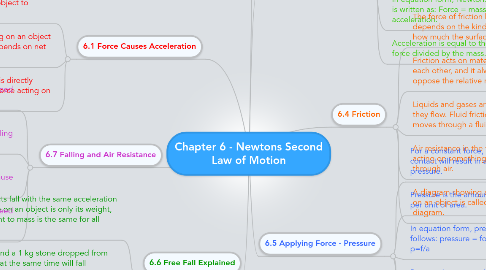Chapter 6 - Newtons Second Law of Motion
作者:Abi Shalom

1. 6.1 Force Causes Acceleration
1.1. Unbalanced forces acting on an object cause an object to accelerate
1.2. The combination of forces acting on an object is the net force; acceleration depends on net force.
1.3. An objects acceleration is directly proportional to the net force acting on it.
2. 6.2 Mass Resists Acceleration
2.1. For a constant force, an increase in the mass will result in a decrease in the acceleration.
2.2. For a given force, the acceleration produced in inversely proportional to the mass. Inversely means that the two values change in opposite directions.
3. 6.6 Free Fall Explained
3.1. All freely falling objects fall with the same acceleration because the net force on an object is only its weight, and the ratio of weight to mass is the same for all objects.
3.2. A 10 kg cannonball and a 1 kg stone dropped from an elevated position at the same time will fall together and strike the ground at practically the same time.
3.3. Since mass and weight are proportional, a 10 kg cannonball experiences 10 times as much gravitational force as a 1 kg stone.
4. 6.7 Falling and Air Resistance
4.1. The air resistance force an object experiences depends on the objects speed and area.
4.2. The force due to air resistance diminishes the net force acting on falling objects.
4.3. Terminal speed is the speed at which the acceleration of a falling object is zero because friction balances the weight.
4.4. Terminal velocity is terminal speed together with the direction of motion.
5. 6.3 Newtons Second Law
5.1. Newtons Second Law states that the acceleration produced by a net force on an object is directly proportional to the magnitude of the net force, is in the same direction as the net force, and is inversely proportional to the mass of the object
5.2. Newtons Second Law describes the relationship among an objects mass, an objects acceleration, and the net force on an object.
5.3. In equation form, Newtons second law is written as: Force = mass x acceleration.
5.4. Acceleration is equal to the net force divided by the mass.
6. 6.4 Friction
6.1. The force of friction between the surfaces depends on the kinds of material in contact and how much the surfaces are pressed together.
6.2. Friction acts on materials that are in contact with each other, and it always acts in a direction to oppose the relative motion
6.3. Liquids and gases are called fluids because they flow. Fluid friction occurs when an object moves through a fluid.
6.4. Air resistance in the friction acting on something moving through air.
6.5. A diagram showing all of the forces acting on an object is called a free-body diagram.
7. 6.5 Applying Force - Pressure
7.1. For a constant force, an increase in the area of contact will result in a decrease in the pressure.
7.2. Pressure is the amount of force per unit of area.
7.3. In equation form, pressure is defined as follows: pressure = force/area of application or p=f/a
7.4. Pressure is measured in newtons per square meter, or pascals (Pa). One newton per square meter is equal to one pascal.
7.5. The smaller the area supporting a given force, the greater the pressure on that surface.


